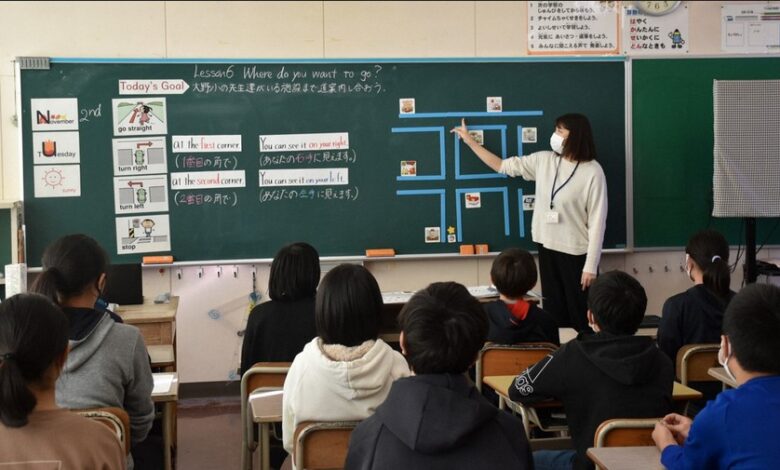How English is Taught in Japanese Schools

English education in Japanese schools has been a topic of intense discussion and reform for decades.
As Japan continues to strengthen its global presence, the ability to communicate in English has become increasingly important.
This article explores the current state of English education in Japanese schools, its historical context, recent reforms, and the challenges that remain.
Historical Context
English education became compulsory in Japanese schools in 1947, following World War II. Initially, the focus was primarily on reading and grammar, with little emphasis on speaking or listening skills.
This approach, known as “yakudoku” (translation-reading), was influenced by the traditional Japanese method of studying classical Chinese texts.
Over the years, the Japanese government has recognized the need for more communicative English education.
However, changes have been gradual, and the legacy of the grammar-translation method continues to influence English teaching in many Japanese classrooms.
Current Structure of English Education
In the Japanese school system, students typically begin formal English education in the fifth grade of elementary school, around age 10-11. However, many schools introduce English activities earlier, sometimes as early as first grade.
Elementary School (grades 5-6): English is taught as a foreign language activity, focusing on listening and speaking skills.
Junior High School (grades 7-9): English becomes a core subject, with increased focus on reading and writing.
High School (grades 10-12): More advanced English is taught, including literature and academic writing.
Teaching Methods and Curriculum
The Japanese Ministry of Education, Culture, Sports, Science and Technology (MEXT) sets the overall curriculum guidelines for English education. In recent years, there has been a push towards more communicative language teaching (CLT) methods. However, the implementation of these methods varies widely between schools and individual teachers.
A typical English class in a Japanese school might include:
1. Vocabulary and grammar exercises
2. Reading comprehension activities
3. Listening exercises (often using CDs or digital materials)
4. Pair or group speaking activities
5. Writing tasks
Many schools also use textbooks approved by MEXT, which form the core of the curriculum. These textbooks have evolved over the years to include more communicative activities, but they still tend to be quite structured and may not always reflect natural English usage.
The Role of Native English Speakers
To enhance English education, many Japanese schools participate in the JET (Japan Exchange and Teaching) Programme or hire Assistant Language Teachers (ALTs) through other means.
These native English speakers work alongside Japanese teachers to provide authentic language input and cultural exchange.
The presence of ALTs has helped to increase students’ exposure to native English and has contributed to a more positive attitude towards English learning among many students.
However, the effectiveness of the ALT system can vary depending on factors such as the ALT’s teaching experience and their relationship with the Japanese teaching staff.
Challenges in English Education
Despite ongoing efforts to improve English education, several challenges persist:
1. Large class sizes: Many English classes in Japan have 30-40 students, making it difficult to provide individual attention or extensive speaking practice.
2. Exam pressure: The emphasis on entrance exams for high schools and universities often leads to a focus on test-taking strategies rather than practical communication skills.
3. Limited exposure to English: Outside of the classroom, many Japanese students have few opportunities to use English in their daily lives.
4. Teacher training: Some Japanese English teachers may lack confidence in their own English speaking abilities, which can affect their teaching approach.
5. Cultural factors: The Japanese cultural emphasis on avoiding mistakes can make some students hesitant to speak English for fear of making errors.
Recent Reforms and Future Directions
Recognizing these challenges, MEXT has implemented several reforms in recent years:
1. Earlier start: English activities were introduced in elementary schools from the third grade in 2011, and English became an official subject from the fifth grade in 2020.
2. Increased lesson time: The number of English lessons has been increased at all levels of schooling.
3. Focus on communication: There’s a greater emphasis on developing students’ communicative competence, including more speaking and listening activities.
4. Use of ICT: Schools are encouraged to incorporate technology into English lessons, including オンライン 英語 online English learning resources.
5. Teacher training: There are ongoing efforts to improve English teachers’ language proficiency and teaching methodologies.
Despite these reforms, change is gradual, and it may take time for their full impact to be felt across the Japanese education system.
Supplementary English Education
Given the limitations of school-based English education, many Japanese students and their families turn to supplementary education options. These include:
1. Juku (cram schools): These private academies often focus on exam preparation but may also offer conversational English classes.
2. Eikaiwa (English conversation schools): These schools specialize in conversational English and often employ native English-speaking teachers.
3. オンライン ネイティブ Online native tutoring: Online platforms that connect students with native English-speaking tutors for one-on-one lessons have become increasingly popular, especially in the wake of the COVID-19 pandemic.
These supplementary options can provide valuable additional exposure to English and opportunities for practice, but they also highlight the perceived inadequacies of the school-based English education system.






